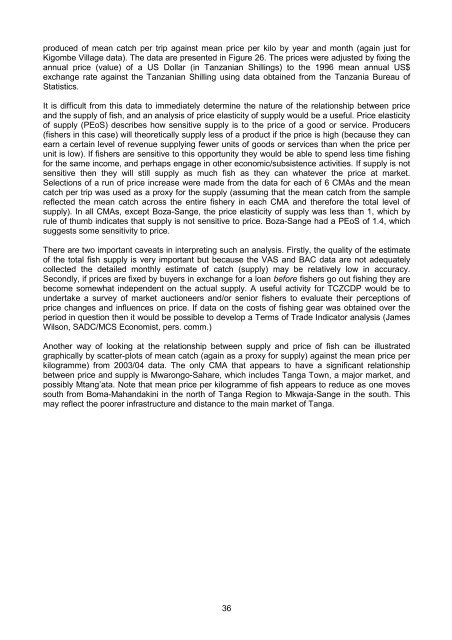Create successful ePaper yourself
Turn your PDF publications into a flip-book with our unique Google optimized e-Paper software.
produced of mean catch per trip against mean price per kilo by year and month (again just for<br />
Kigombe Village data). The data are presented in Figure 26. The prices were adjusted by fixing the<br />
annual price (value) of a US Dollar (in Tanzanian Shillings) to the 1996 mean annual US$<br />
exchange rate against the Tanzanian Shilling using data obtained from the Tanzania Bureau of<br />
Statistics.<br />
It is difficult from this data to immediately determine the nature of the relationship between price<br />
and the supply of fish, and an analysis of price elasticity of supply would be a useful. Price elasticity<br />
of supply (PEoS) describes how sensitive supply is to the price of a good or service. Producers<br />
(fishers in this case) will theoretically supply less of a product if the price is high (because they can<br />
earn a certain level of revenue supplying fewer units of goods or services than when the price per<br />
unit is low). If fishers are sensitive to this opportunity they would be able to spend less time fishing<br />
for the same income, and perhaps engage in other economic/subsistence activities. If supply is not<br />
sensitive then they will still supply as much fish as they can whatever the price at market.<br />
Selections of a run of price increase were made from the data for each of 6 CMAs and the mean<br />
catch per trip was used as a proxy for the supply (assuming that the mean catch from the sample<br />
reflected the mean catch across the entire fishery in each CMA and therefore the total level of<br />
supply). In all CMAs, except Boza-Sange, the price elasticity of supply was less than 1, which by<br />
rule of thumb indicates that supply is not sensitive to price. Boza-Sange had a PEoS of 1.4, which<br />
suggests some sensitivity to price.<br />
There are two important caveats in interpreting such an analysis. Firstly, the quality of the estimate<br />
of the total fish supply is very important but because the VAS and BAC data are not adequately<br />
collected the detailed monthly estimate of catch (supply) may be relatively low in accuracy.<br />
Secondly, if prices are fixed by buyers in exchange for a loan before fishers go out fishing they are<br />
become somewhat independent on the actual supply. A useful activity for TCZCDP would be to<br />
undertake a survey of market auctioneers and/or senior fishers to evaluate their perceptions of<br />
price changes and influences on price. If data on the costs of fishing gear was obtained over the<br />
period in question then it would be possible to develop a Terms of Trade Indicator analysis (James<br />
Wilson, SADC/MCS Economist, pers. comm.)<br />
Another way of looking at the relationship between supply and price of fish can be illustrated<br />
graphically by scatter-plots of mean catch (again as a proxy for supply) against the mean price per<br />
kilogramme) from 2003/04 data. The only CMA that appears to have a significant relationship<br />
between price and supply is Mwarongo-Sahare, which includes <strong>Tanga</strong> Town, a major market, and<br />
possibly Mtang’ata. Note that mean price per kilogramme of fish appears to reduce as one moves<br />
south from Boma-Mahandakini in the north of <strong>Tanga</strong> Region to Mkwaja-Sange in the south. This<br />
may reflect the poorer infrastructure and distance to the main market of <strong>Tanga</strong>.<br />
36
















